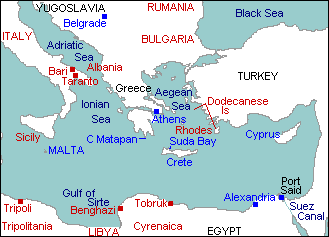1939
SEPTEMBER
1939
3rd -
After Germany invaded Poland on the 1st,
Britain and
France demanded the withdrawal of German forces.
The
ultimatum expired and at 11.15am on the 3rd,
Prime
Minister Neville Chamberlain broadcasts to
announce that Britain
was at war with Germany. Italy
declared its neutrality.
1940
JUNE
1940
Italy
declared war on Britain and France
Strategic
Situation in the Mediterranean - In the
western half, Britain and France between them
controlled Gibraltar, southern
France, Corsica, Algeria and Tunisia. In the
eastern
half, Britain maintained a hold on Egypt and the
Suez Canal, Palestine and Cyprus. In the Levant,
Lebanon
and Syria were French. Italy stood astride the
central basin,
with Italy itself, Sardinia and Sicily to the
north and
Libya to the south. Albania on the Adriatic Sea
and the
Dodecanese Islands in the southern Aegean off
Turkey were
Italian. The
islands were taken from Turkey in 1912
and included - from north to south - Patmos,
Leros, Kos,
Kalymnos and the much larger island of Rhodes.
The Neutral countries
in the
western Mediterranean were Spain, and in the
east, Greece
and Crete, Yugoslavia and Turkey.
AUGUST
1940
Eastern Europe - The
Germans
started planning the invasion of Russia.
SEPTEMBER
1940
Axis Powers -
Germany, Italy and Japan signed the Tripartite
Pact
in Berlin on the 27th. They agreed to jointly
oppose any
country joining the Allies at war - by which
they meant
the United States.
OCTOBER
1940
Eastern
Europe
- German troops occupied the Rumanian
oilfields.
Balkans - On
the
28th, the Italians invaded Greece from points in
Albania,
but were soon driven back. Fighting continued on
Albanian
soil until April 1941.
NOVEMBER
1940
Eastern
Europe/Balkans
- Hungary and Rumania joined the Axis
Tripartite Pact
on the 20th and 23rd. Only Yugoslavia and
Bulgaria held
out against German pressure to become members;
the only
countries in Eastern Europe and the Balkans not
completely dominated by the Axis or Russia.
Balkans - As
the
Greek Army pushed back the Italians into
Albania, RAF
squadrons were sent from Egypt to Greece and the
Royal
Navy carried over the first Australian, British
and New
Zealand troops by cruiser. Mediterranean Fleet
established an advance base at Suda Bay on the
north
coast of Crete.
DECEMBER
1940
Eastern
Europe
- Hitler ordered detailed planning for
Operation 'Barbarossa' - the invasion of Russia.
Crete
- At anchor in the poorly defended Suda Bay,
cruiser "Glasgow" was hit by two torpedoes
from Italian aircraft on the 3rd and badly
damaged.
Attacks on Albania
and
the Dodecanese - Another series of Royal
Navy convoy
and offensive operations were carried out by the
Mediterranean Fleet with battleships
"Warspite", "Valiant "and carrier
"Illustrious". On the 17th carrier aircraft
attacked Rhodes and on the night of the
18th/19th the two
battleships bombarded Valona, Albania.
1941
JANUARY
1941
Malta
Convoy "Excess"
- Another
complex
series of Royal Navy convoy and ship movements
revolving around Malta led to carrier
"Illustrious" being
badly damaged and the Royal Navy losing
its comparative freedom of operation in the
Eastern
Mediterranean. The operations included convoy
'Excess'
leaving Gibraltar on the 6th for Malta and
Greece covered
by Gibraltar-based Force H. All merchantmen
reach their
destinations safely, but at a cost of a cruiser
and
destroyer, and the loss of "Illustrious'" vital
air power.
19th -
Destroyer
Greyhound, escorting a convoy to Greece, sank
Italian
submarine "NEGHELLI" in the Aegean Sea
MARCH
1941
Eastern
Europe/Balkans
- Bulgaria joined the Tripartite Pact on the 1st
March
and German troops marched in. As of now, only
Yugoslavia
in the Balkans retained national independence
Greece - In
the
space of three weeks in March, 60,000 British
and
Dominion troops were carried from North Africa
to Greece,
escorted by the Royal Navy (Operation 'Lustre').
6th - Italian
submarine "ANFITRITE" attacked a troop convoy
east of Crete and
was sunk by escorting destroyer
"Greyhound".
26th - At
anchor in
Suda Bay, northern Crete, heavy cruiser "YORK"
was badly
damaged by Italian explosive
motor boats and beached. She was later wrecked
by bombing
and abandoned when Crete was evacuated in May.
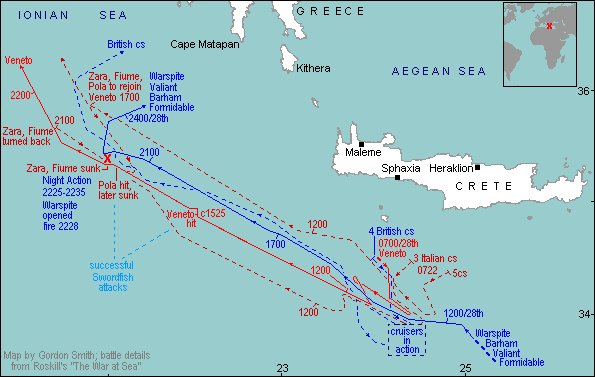
Battle of Cape Matapan
(above) - As ships
of the
Mediterranean
Fleet covered troop movements to Greece,
'Ultra' intelligence was received reporting the
sailing
of an Italian battlefleet with one battleship,
six heavy
and two light cruisers plus destroyers to attack
the
convoy routes. On the 27th, Vice-Adm
Pridham-Wippell with cruisers "Ajax",
"Gloucester", "Orion" and the
Australian "Perth" and destroyers sailed from
Greek waters for a position south of Crete. Adm
Cunningham with carrier "Formidable" and
battleships "Warspite", "Barham" and
"Valiant "left Alexandria on the same day to
meet the cruisers. Around 08.30 on the 28th,
south of Crete, Adm Pridham- Wippell was in
action with
an Italian cruiser squadron. Just before noon he
found
himself between them and the battleship
"Vittorio
Veneto" which had now come up. An attack by
Swordfish from "Formidable" failed to hit the
Italian battleship, but enabled the British
cruisers to
extricate themselves. Mediterranean Fleet heavy
units
arrived, but their only chance of action was to
slow down
the Italians before they could reach Italy.
A second Swordfish
strike
at around 15.00 hit and slowed down
"Vittorio
Veneto", but only
for a short while. At 19.30 a third
strike
southwest of Cape Matapan stopped heavy cruiser
"Pola". All this time, RAF aircraft were
attacking but without success. Later that
evening
(still on the 28th), two more heavy cruisers -
"Fiume" and "Zara with four destroyers
were detached to help "Pola". Before reaching
her, Adm Cunningham's ships detected them by
radar and "FIUME",
"ZARA" and
destroyers "ALFIERI" and "CARDUCCI"
were
crippled by the close range gunfire
of "Barham", "Valiant" and
"Warspite". All four Italians were finished off
by four destroyers led by the Australian
"Stuart". Early next morning on the
29th, "POLA"
was found,
partly abandoned. After taking off
the remaining crew, destroyers "Jervis" and
"Nubian" sank her with torpedoes. The Royal
Navy lost one aircraft.
31st -
Cruiser "BONAVENTURE" with a Mediterranean Fleet
cruiser
force escorting a convoy from Greece to Egypt,
was
torpedoed and sunk to the southeast of Crete by
Italian
submarine "Ambra".
Yugoslavia -
On the
25th Yugoslavia joined the Tripartite Pact, but
two days
later an anti-Nazi coup toppled the Government.
APRIL
1941
Yugoslavia
and
Greece - Germany
invaded
both countries on the 6th. By the 12th they
entered Belgrade and within another five days
the
Yugoslav Army had surrendered. Greek forces in
Albania
and Greece suffered the same fate. Starting on
the 24th
over a period of five days, 50,000 British,
Australian
and New Zealand troops were evacuated to Crete
and Egypt
in Operation 'Demon'. The Germans occupied
Athens on the
27th.
27th - As
units of
the Mediterranean Fleet carried out the Greek
evacuation,
destroyers "DIAMOND" and "WRYNECK" rescued
troops from the bombed
transport "Slamat", but were then sunk by more
German bombers off Cape Malea at the southeast
tip of
Greece. There were few survivors from the three
ships.
MAY
1941
18th - On
patrol
south of Crete, AA cruiser "Coventry"
was heavily
attacked from the air. +
Petty Officer Alfred Sephton continued to carry
out his
duties in the director after being mortally
wounded. He
was posthumously awarded the Victoria Cross.
21st
May-1st June -
Battle for Crete
-
On the 21st, in the
opening stages
of the attack on Crete, cruiser minelayer
"Abdiel" laid mines off the west coast of
Greece sinking Italian destroyer "MIRABELLO" and
two transports. Most of the
Mediterranean Fleet with four battleships, one
carrier,
10 cruisers and 30 destroyers fought the Battle
for
Crete. For the Navy there were two
phases,
both of which took place under intense air
attack, mainly
German, from which all losses resulted. Phase
One was from the German airborne invasion
on the 20th until the decision was taken on the
27th to evacuate the island.
During this time the Mediterranean Fleet managed
to
prevent the sea-borne reinforcement of the
German
paratroops fighting on Crete, but at heavy cost.
Most of
these losses happened as the ships tried to
withdraw from
night-time patrols north of the island out of
range of
enemy aircraft.
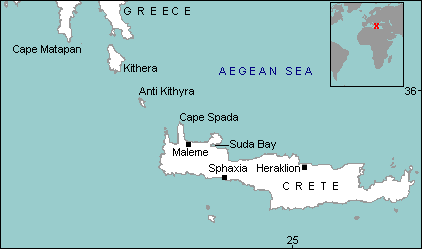
Phase Two was
from
27th May to 1st June when over 15,000 British
and
Dominion troops were evacuated. Ten thousand had
to be
left behind - and again the naval losses were
heavy. 21st
- In the morning destroyer "JUNO"
was sunk
and cruiser "Ajax" slightly damaged as they
withdrew
southeast of Crete. Later that evening "Ajax",
with "Dido", "Orion" and four
destroyers, savaged a German troop convoy of
small craft.
More such vessels were sunk over the next few
days off
the north coast. 22nd - Early that
morning another
force of four cruisers and three destroyers
swept to the
north and was attacked on their return. Cruisers
"Naiad" and
"Carlisle"
were damaged,
and as they reached their support
force to the northwest, battleship "Warspite"
was badly
hit. Later, destroyer "GREYHOUND"
was
caught on her
own in the same area
and soon sent to the bottom. Other destroyers
went to
rescue her survivors, covered by cruisers
"Gloucester" and "Fiji". As the
cruisers withdrew, first "GLOUCESTER"
was sunk
northwest of Crete by Ju87s and
Ju88s. Three hours later "FIJI"
was surprised
by a single Me109
fighter-bomber and sank to the southwest. All
ships were
very short of AA ammunition by this stage. 23rd
-
Withdrawing from the usual night-time patrols
led to the
loss of two more destroyers. Capt Lord Louis
Mountbatten's five ship flotilla was attacked to
the
south and "KASHMIR" and "KELLY" sunk. Over the
next few days the north
coast sweeps continued, and supplies and
reinforcements
were brought into Crete.
26th - Carrier
"Formidable", accompanied by battleships
"Barham" and "Queen Elizabeth", flew
off aircraft from a position well to the south
for an
attack on the Scarpanto Island airfields. In the
counter-attack "Formidable" and destroyer
"Nubian" were
damaged. 27th
- As "Barham" covered a supply mission, she was
hit to the northwest of Alexandria. 28th
- The
decision to evacuate was made, and cruisers and
destroyers prepared to lift off the troops. As
they
approached Crete, cruiser "Aiax" and destroyer
"Imperial"
were
damaged to
the southeast. 29th
- Early in the morning, 4,000 men were lifted
off from
Heraklion on the north coast. As they did the
damaged "IMPERIAL"
had
to be
scuttled, and "HEREWARD"
was
hit and left behind to go down off
the eastern tip of Crete. Shortly, cruisers
"Dido"
and "Orion" were
badly damaged
to the southeast. 30th
- Early in the day, more troops were lifted from
the
southern port of Sphakia by another cruiser
force. Well
to the south the Australian cruiser "Perth"
was bombed
and damaged. 1st June -
As the last men were carried from Crete,
cruisers
"Calcutta" and "Coventry" sailed from
Alexandria to provide AA cover. "CALCUTTA"
was
sunk north of the Egyptian coast.
Some 15,000 troops were saved but at a cost to
the Royal
Navy of 2,000 men killed. Total warship
casualties, all
from German and some Italian bombing were:
|
Warship
types |
Sunk
|
Badly
damaged
|
Total
|
|
Battleships
|
-
|
2
|
2
|
|
Carriers
|
-
|
1
|
1
|
|
Cruisers
|
3
|
5
|
8
|
|
Destroyers
|
6
|
5
|
11
|
|
Totals
|
9
|
13
|
22
|
JUNE
1941
|
Germany
Attacks Russia - On the 22nd
the German
attack on Russia (Operation
'Barbarossa') started
with the eventual aim of destroying
the Russian
Armies and occupying the whole of
the country
west of the line Archangel in the
Arctic to the
Caspian Sea. Germany and its Axis
partners
including Italy invaded from the
Baltic to the
Black Sea. Italy and Romania
declared
war on Russia
on the 22nd. Finland followed on the
26th and
Hungary on the 27th.
|
Malta
- With German forces now in
Greece and Crete, the problems of supplying
Malta were
even greater. From airfields in
Crete
as well as Libya, the
Luftwaffe and
Italian Air force were as close to the eastern
convoy
routes from Alexandria, as Sardinia and Sicily
were to
the western ones through the Strait of
Gibraltar.
JULY
1941
5th
-
Submarine "Torbay" on patrol in the Aegean Sea
sank Italian submarine "JANTINA".
OCTOBER
1941
20th
-
Mines previously laid by submarine "Rorqual" in
the Gulf of Athens sank Italian torpedo boats
"ALDEBARAN" and "ALTAIR".
DECEMBER
1941
Declarations
of War - In a
series of diplomatic moves, numerous
declarations of war
were made: (1) 5th-6th - Britain,
Australia,
Canada, New Zealand and South Africa on Hungary
and
Rumania. (2) 11th-13th -
Italy,
Rumania, Bulgaria and Hungary against the United
States.
(3) 28th-14th January - Britain,
Australia, New
Zealand and South Africa against Bulgaria.
6th -
Submarine
“PERSEUS” on
patrol off the west coast of Greece was mined
and sunk
off Zante Island. Just one man made an amazing
escape to
the surface and reached the distant shore.
11th -
Submarine
“Truant” sank Italian torpedo boat “ALCIONE”
north of Crete.
1942
JANUARY
1942
Early January -
Submarine "TRIUMPH"
sailed
from
Alexandria on 26th December for
a cloak-and-dagger landing near Athens before
patrolling
in the Aegean. She reported the landing on the
30th, but
failed to rendezvous back there on the 9th and
was
presumed mined off the island of Milo, southeast
of the
Greek mainland.
30th -
Italian
submarine "MEDUSA"
was
torpedoed by
"Thorn" in the
Gulf of Venice, in the far north of the
Adriatic.
FEBRUARY
1942
16th
-
British submarine "Thresher"
was counter-attacked
by the escorts of a
convoy off northern Crete. Two unexploded bombs
lodged
between the casing and hull, and with the
likelihood of
drowning should she be forced to submerge, two
of the
boat's crew managed to remove them. Lt Peter
Roberts RN
and Petty Officer Thomas Gould were awarded the
Victoria Cross.
MARCH
1942
4th - Another
British submariner won the Victoria Cross. HM
Submarine
Torbay (Cdr Miers) carried out a difficult
attack on
shipping off Corfu, an island on the west coast
of Greece
and torpedoed two merchantmen. This was only the
latest
of a number of successful patrols. Cdr Anthony
Miers RN
was awarded the Victoria Cross.
18th -
Italian
submarine "TRICHECO"
went down
off Brindisi in the southern
Adriatic, torpedoed by "Upholder" (Lt-Cdr
Wanklyn).
AUGUST
1942
6th
-
Submarine "THORN" attacked a tanker off
southwest Crete and
was presumed sunk in the counter-attack by
Italian escort
destroyer "Pegaso".
NOVEMBER
1942
Allied
Invasion of French North Africa
DECEMBER
1942
15th
-
Destroyers "Petard" and Greek "Queen
Olga" sank
Italian submarine "UARSCIEK" south of Malta.
1943
APRIL
1943
21st - Royal
Navy
submarine "SPLENDID"
was
sunk by German
destroyer
"Hermes" (ex-Greek) south of Capri.
'The Man Who Never
Was'- Submarine "Seraph" released the body
of a supposed Royal Marine officer into the sea
off
Spain. His false papers help to persuade the
Germans that
the next Allied blows would fall on Sardinia and
Greece as well as Sicily.
MAY
1943
Resistance
Forces - In occupied Europe, Tito's
partisan armies
continued to hold down large numbers of German
troops in
Yugoslavia.
JUNE
1943
2nd
-
Destroyers "Jervis" and Greek "Queen
Olga" sank two
merchantmen and Italian torpedo boat "CASTORE"
off Cape Spartivento,
southwest Italy.
JULY
1943
Invasion
of Sicily: Operation 'Husky'
AUGUST
1943
11th
-
British submarine "PARTHIAN"
was overdue
on this date. She left
Malta on 22nd July for the southern Adriatic and
failed
to return to Beirut.
SEPTEMBER 1943
Italy
- Surrender
and Invasion
British
Aegean Campaign - With the surrender of
Italy,
Winston Churchill wanted to seize the Italian
Dodecanese
islands in the southern Aegean before the
Germans could
establish themselves. From here the Allies could
threaten
Greece and support Turkey, but the Americans and
some
British commanders were lukewarm to what they
saw as a
sideshow compared with the battle for Italy.
Insufficient
forces and especially aircraft were made
available, and
the Germans soon took Rhodes from where,
together with
other bases, they maintained air superiority
throughout
the coming campaign.
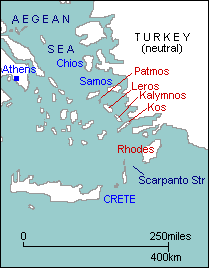
On the
15th
and 16th, British troops occupied Kos, Leros,
Samos and
other smaller islands. The Royal Navy had the
task of
supplying and reinforcing them, as well as
attacking
German supply routes. The potential parallels
with
Norway, Greece and Crete all those many months
back were
obvious, if only in hindsight. 26th -
After
carrying troops to Leros, destroyers "Intrepid"
and Greek "Queen Olga" were
attacked by Ju88s while at anchor in the
harbour. "QUEEN
OLGA" soon went
down and "INTREPID" capsized next day.
OCTOBER
1943
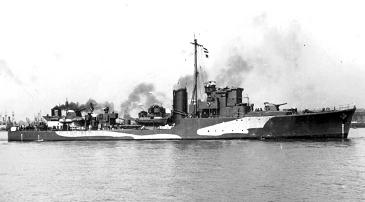
HHMS Adrias of
the Royal Hellenic Navy (CyberHeritage)
British
Aegean Campaign - On the 3rd,
German troops
landed on British-held Kos, which fell next day.
More
German forces headed for the Kos and on the 7th
a
convoy of seven small ships and one escort was
annihilated by cruisers "Penelope" and
"Sirius" and two destroyers. As they withdrew
through the Scarpanto Strait, "Penelope"
was
damaged in attacks by
Ju87s and
Ju88s. More sweeps and more supply trips led to
further
losses, particularly amongst the 'Hunts',
through to
November: 9th - Returning from a sweep
west of
Kos, cruiser "Carlisle" and destroyers were
dive-bombed in the Scarpanto Strait area by Ju87
Stukas. "CARLISLE"
was
seriously
damaged and never fully
repaired; destroyer PANTHER
was sunk.
17th - Cruiser "Sirius"
was damaged by bombs
south of Scarpanto Strait. 22nd - Greek
'Hunt' "ADRIAS"
was
badly damaged
off Kos on mines laid
by the German "Drache", and as sister ship
"HURWORTH"
went
to her aid,
was also mined. She
sank with heavy casualties. 24th -
Destroyer "ECLIPSE" fell victim to the same
minefield.
30th - Cruiser "Aurora"
was damaged
in bombing attacks.
Mid-October
- A Royal Navy submarine failed to return.
"TROOPER" set out from Beirut in the Lebanon
on 26th September for Dodecanese patrol and did
not get
back on the 17th. German records claim she was
sunk by a
Q-ship off Kos on the 14th
NOVEMBER
1943
British
Aegean Campaign, Conclusion - German
forces landed on Leros on
the 12th and captured the Island after four
day's heavy
fighting against the British and Italian
defenders. The
campaign came to an end when Samos was evacuated
on the
20th, but not before two more 'Hunts' fell
victim, this
time to Hs293 glider bombs: 11th -
"ROCKWOOD"
was
severely
damaged off Kos following
an attack with other destroyers on Kalymnos
(Calino). She
was not repaired and went into reserve. 13th
-
"DULVERTON"
was
sunk
off Kos as she withdrew from searching for
German
shipping making for Leros. The cost of this
abortive
campaign to the Royal Navy could now be added up
- four
cruisers damaged with one never repaired, six
destroyers
lost or permanently out of action and others
damaged. In
addition the small Greek Navy had lost two
destroyers.
Mid-November
- Submarine "SIMOOM"
sailed
from Port
Said on the 2nd for the
Aegean and failed to answer a signal on the
19th. She was
presumed mined although German records claim she
was
torpedoed by "U-565" off Kos on the 15th.
DECEMBER
1943
Eastern
Front - In the centre/south all
the Ukraine
east of the Dnieper River together with deep
bridgeheads
across much of its length were now in Russian
hands. They
prepared to recover the rest of the Ukraine,
push into
the Crimea and move on Poland and Rumania.
Mediterranean
War
at Sea - With the surrender of the Italian
fleet,
the big ships of the Royal Navy were released
for the
Eastern Fleet and to prepare for the landings in
Normandy. The remaining smaller vessels
continued to
escort the convoys needed to supply the Allied
forces in
Italy, and to support both Fifth and Eighth
armies on
their seaward flanks. The RN also went over to
the
offensive against Germany supply traffic down
the west
coast of Italy and from the northeast through
the Adriatic to Yugoslavia.
From bases such as Corsica and
Bari, light and coastal forces struck regularly
at
shipping, and also at land targets along the
coast of Yugoslavia
in support of
Tito's partisan armies.
1944
JANUARY
1944
Anzio
Landings, western Italy, Operation
'Shingle'
MARCH
1944
Eastern
Front
- Nearly all the Ukraine was now back in
Russian hands and in the south the advance
towards the
southwest brought the Russians to the foothills
of the
Carpathian mountains, just inside pre-war Rumania.
Thoroughly concerned about the
potential collapse of the Balkans, Hitler orders
troops
into Hungary to prevent the country leaving the
Axis.
MAY
1944
Eastern Front
-
Against fierce German resistance, the Russians
in the
south had now re-captured all the Ukraine
including the
Crimea. In the centre, they were over the border
into
pre-war Poland and Rumania.
Mediterranean
Merchant
Shipping War - U-boats had only managed to
sink 10
merchantmen in the Mediterranean in the first
five months
of 1944. In return 15 had been lost, including
three
breaking through the Strait of Gibraltar and
four in
USAAF raids on Toulon, southern France and Pola
in the northern Adriatic.
JUNE
1944
Normandy
Invasion: Operation
'Overlord'
Early/Mid June
-
Submarine "SICKLE" on patrol in the Aegean
failed to return to
Malta when recalled on the 14th, and was
presumed lost on
mines.
18th -
Destroyer "QUAIL", damaged by a mine in the
southern
Adriatic seven months earlier in November 1943,
foundered
off south-eastern Italy on tow from Bari around
to
Taranto.
AUGUST
1944
Eastern
Front - Nearly all pre-war Russia had now
been
liberated. The summer offensive started in the
far south,
aimed at clearing the Balkans. The Russian
armies
attacked on the 20th from the Ukraine south and
west into
Rumania. Events moved rapidly. Three
days
later Rumania accepted the Russian armistice
terms, on
the 25th declared war on Germany, and by the
31st the
Russians were entering Bucharest. Now Bulgaria
tried to declare its neutrality and
withdraw from the war, just as the Russian
forces swung
west and north towards Hungary and on to Yugoslavia
threatening to cut off the Germans
in Greece.
SEPTEMBER
1944
Eastern Front
- In
the Balkans, Rumania signed an Allied
armistice in Moscow on the
12th, by which time its troops were in battle
alongside
the Russians. The country was almost free of the
Germans
by the end of the month. From Rumania, the
Russians
reached the eastern border of Yugoslavia
by the 6th and crossed into
southern Hungary before September was out.
Russia
declared war on Bulgaria on the 5th,
which in turn declared against
Germany three days later as Russian forces
crossed into
the country near the Black Sea. They entered
Sofia on the
16th and at the end of October an armistice was
signed
with the Allied powers. By then Bulgarian troops
were
attacking into Yugoslavia with the
Russians.
Greece - As
the
Russians attacked through Rumania and Bulgaria
towards
Yugoslavia, German troops started to evacuate
Crete,
southern Greece and the islands of the Aegean.
However
right up until May 1945, garrisons held out on
Rhodes,
western Crete and some of the Greek Islands.
End of the
Mediterranean U-boats - The last U-boats
in the
Mediterranean were lost to sea and air attack.
On the 19th
schnorkel-equipped "U-407"
was
sunk north of Crete by
destroyers
"Terpischore", "Troubridge" and the
Polish "Garland" of Adm Troubridge's escort
carrier and cruiser force. Five days later in
raids on
Salamis near Athens, USAAF aircraft sank "U-596"
and the damaged "U-565".
Royal Navy
Submarine
Operations - These too drew to a close.
With so few
German targets left, the famous 10th Submarine
Flotilla
was disbanded although some of the boats
continued to
work out of Malta in the Aegean. The last
British
submarine sunk was "Sickle" three months
earlier in June, the 45th Royal Navy loss in the
Mediterranean.
OCTOBER
1944
Eastern Front
- In
the Balkans, the struggle up through
Hungary
continued,
but the Russians could only
reach the outskirts of Budapest in early
November.
Meanwhile the Eastern Allies were advancing into
Yugoslavia and joined forces with units
of
Marshall Tito's partisan armies on the 4th.
Belgrade fell
on the 20th.
Adriatic -
Returning from bombarding shore targets on the
northeast
coast of Italy, destroyer "LOYAL"
was mined
in the Adriatic on the 12th
and not repaired.
Greece - The
Germans were now coming to the end of the
evacuation of
the Aegean area and northern Greece as British,
Greek and
Allied troops landed in the south and on many of
the
islands. On the 12th Allied paratroops dropped
near
Athens. Adm Troubridge's force continued to
sweep the
Aegean for German evacuation shipping as Royal
Navy
submarines also took a toll. 7th - Destroyers
"Termagant"
and "Tuscan" sank torpedo
boat "TA-37" in the Gulf of Salonika. 19th
- Further south it was the turn of "TA-18", lost
to the same two British
destroyers. Both were ex-Italian vessels.
NOVEMBER
1944
Eastern Front -
The
main activity was in Hungary where the Russians
still
battle towards Budapest, and in the Balkans as
southern Yugoslavia
was cleared by the Eastern
Allies.
Adriatic -
Off Zara
in the northern Adriatic on the 1st, escort
destroyers
"Avon Vale" and "Wheatland" sank
German torpedo boat "TA-20" and two corvettes -
all ex-Italian.
Greece &
Albania
- By mid-month Greece was free of those Germans
that
could escape and British troops had landed in
the north.
They also had the job of disarming the various
resistance
movements. In Albania the Germans were pulling
out and on
the 21st the capital of Tirana was occupied by
Albanian
partisans.
DECEMBER
1944
Adriatic -
'Hunt'
escort destroyer "ALDENHAM"
was
the
67th and last Royal
Navy destroyer
lost in the Mediterranean. Returning from
bombarding a
German-held island off Fiume in the northern
Adriatic on
the 14th, she was mined and sunk northwest of
Zara.
Greece -
Disagreements with the Greek communist movement
EAM/ELAS
over the future government of the country led to
fighting
and the declaration of martial law. British
troops,
supported by Royal Navy ships, had the
unenviable task of
fighting their previous allies. By month's end
the
fighting started to die down as proposals for
the
setting-up of a regency were announced. The
troubles were
not over until February 1945, and trouble flared
again
with the outbreak of civil war in 1946.
|
Strategic
Situation -
Mediterranean - All the
Mediterranean except the
Ligurian Sea to the north of
Corsica, the
northern part of the Adriatic and
some of the
Greek islands were now under Allied
maritime
control
|
1945
FEBRUARY
1945
12th -
Attacks by
German explosive motorboats were made on
shipping in
Split harbour, Yugoslavia, hitting a flak
landing craft
and damaging cruiser "Delhi" laying alongside.
17th - Italian
battleship "CONTE DI CAVOUR", sunk in the 1940
Fleet Air Arm
attack on Taranto and salvaged but not
recommissioned,
was finally destroyed in RAF raids on Trieste.
APRIL
1945
Italy - Eighth
Army
started towards the Argenta gap on the 9th, and
by the
18th was through. US Fifth Army moved on Bologna
on the
14th and a week later captured the city.
British,
Brazilian, Indian, New Zealand, Polish, South
African and
US divisions of Fifth and Eighth Armies then
reached the
River Po and raced across the north of Italy. By
the end
of the month, Spezia, Genoa and Venice had been
liberated.
Adriatic -
Torpedo
boat
"TA-45"
was
sunk
by coastal forces off Fiume in the northern
Adriatic on
the 13th, the last major enemy warship to fall
victim to
the Royal Navy in the Mediterranean.
MAY
1945
German
Forces in Italy Surrendered
